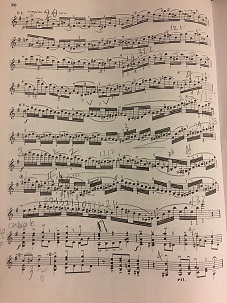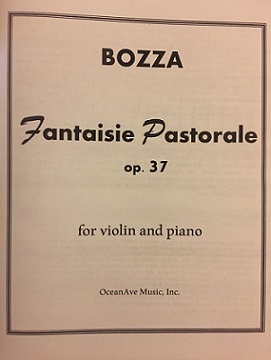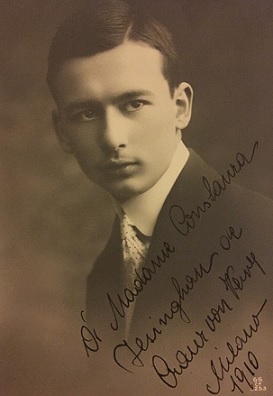Transcriptions and cadenzas for violin and piano
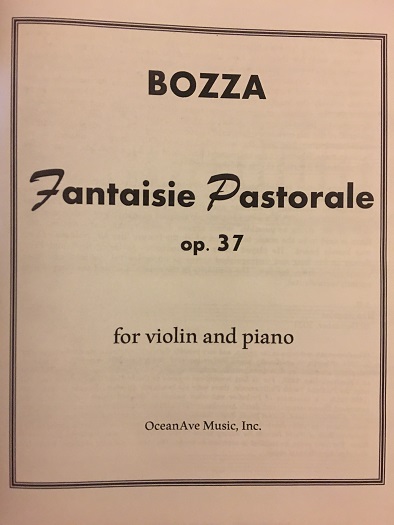
VIOLIN HISTORY
The ability to write music for one's own instrument is a special one that not many have - that is, to write really outstanding music that will enter the repertoire is a significant task requiring a lot of talent. "They made 'em better in the old days" is completely true when it comes to quality music, and not just classical. Throughout the history of classical music - all 4 or so centuries of it - performing artists have taken compositions originally written for other instruments and transcribed or arranged them for their own. The violin world has been infinitely blessed by Jascha Heifetz, Nathan Milstein, Josef Szigeti, Ruggiero Ricci, and many others who have transcribed hundreds of orchestral and piano works, or extracts therefrom, as violin-piano recital pieces. Heifetz's "second career" was as one of the most prolific arrangers/transcriptionists in classical music history - and he not only wrote the violin parts, but the piano parts as well. I am happy to have added my own extremely modest contribution to this effort.
Here is a Presentation on Violin and Piano Transcriptions that I put together awhile back. Here is the Participant Handout as well.
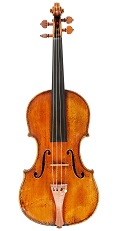
VIOLIN AND PIANO TRANSCRIPTIONS and CADENZAS
If you are interested in purchasing, you can find them on SheetMusicPlus.com website. If you have trouble finding them, email me and I will provide you with direct link so you can purchase. They are all affordably priced at under $10.00 per copy/download. socalviolin1985@gmail.com
#1. "Elfentanz" ("Dance of the Elves"), op. 39 by David Popper. This warhorse cello showpiece is now available as a violin-piano transcription. In the late 1800s, the violinist Sauret also transcribed this piece, but unfortunately it never entered the repertoire and got no recordings that have survived. These new violin and piano parts combine forces to make for a most memorable closing recital number or encore. A raucous 'perpetuum mobile', it is perhaps the only such piece of its title to capture all the joy and mischief of life as an elf. Performing time: Roughly 3 minutes depending on tempo.
#2. "Fantaisie Pastorale", op. 37 by Eugene Bozza. The French composer Bozza is primarily known to audiences for his wind instrument works. "Fantaisie Pastorale" (1939) was written as an advanced piece for oboists, and it has remained in the standard oboe repertoire. It has also been transcribed for other instruments - but this is its first string transcription. A two-part work with a difficult accompanied cadenza highlights this noble piece, which serves as an effective recital opener. Performing time: 7 minutes.
#3. "Adagietto" by Gustav Mahler. Mahler, the symphonist, did not write many solo works. The third movement of the Fifth Symphony - one of the great fifth symphonies - has been transcribed as a violin-piano recital number. Performing time: 5 minutes.
#4. Six Movements from "Pictures at an Exhibition" by Mussorgsky. Every concert pianist knows this popular solo recital piece, but most know the orchestra transcription by Ravel. Now, it takes on a new life as a violin-piano suite comprised of six movements of the original twelve. (To be completed in 2024.)
#5. Homage a Respighi. Extracts from some of Respighi's popular works, and a few less-popular, comprise this work for violin and piano. (To be completed in 2024.)
#6. Two Dances from "Namouna" by Edouard Lalo (1823-1892). Most people know Lalo for one piece and one piece only - the "Symphonie Espagnole" for violin and orchestra, which is played worldwide and a staple of the violin repertoire. However, as a composer he is underrated. While Lalo did not write a huge volume of classical music, he wrote a handful of masterworks including four violin concerti, the Cello Concerto in D minor, which is also standard repertoire, an opera called Le Roi d'Ys" (The King of Ys), and a ballet called "Namouna", from which I have extracted two of the best movements, "Dolce Far Niente - La Sieste", and "Mazurka." Together, these two contrasting dance movements make for a fine recital number. Performing time: about 9 minutes.
#7. "Polovetsian Dances" by Alexander Borodin. The popular orchestra number, sometimes even performed with chorus, is abbreviated into a brilliant showpiece for violin and piano. (In progress.)
#8. The pithy and even rather sarcastic Caprice XVII in Eb major by Nicolo Paganini is one of the greatest etudes ever written for the instrument, and one of the most challenging. Paganini had a delightful sense of humor despite his rather dour stage presence and this is ever-present in his compositions. The 24 Caprices were written as etudes, but most of them appear on recital programs because they are quite musical. Several of the greatest composers have written piano accompaniments for some/all 24 including Schumann, who indeed wrote accompaniments for all 24. I have written my own accompaniment for Caprice XVII.
#9. Caprice XV by Pierre Rode is one of the nicest of the Rode "24 Caprices". Like the Paganini Caprices, some of the Rode Caprices have piano accompaniments written by others over the years. But this is one that I'd never heard with piano. Now it has a piano part...or another one!
#10. Cadenza for Beethoven Violin Concerto, Mvt 3. The titanic Beethoven Concerto for the violin has had dozens of cadenzas written by various people, including the composer himself. He also wrote a Piano Concerto transcription of the Violin Concerto! However, those who wrote the cadenzas generally only wrote them for the 1st movement, and did not write any for the 3rd movement.
#11. Cadenza for Wieniawski Violin Concerto #1 in F# minor, Mvt. 1. This piece has only one known cadenza - or at least, only one that has been published in its nearly 200 year history, and that's the one by the composer. This suggests that it is a robust enough cadenza that no further ones need be attempted. I disagreed, and came up with one of my own, which also includes a 20 bar new orchestral tutti.
#12. Cadenza for Szymanowski Violin Concerto #1. The composer's friend, violinist Pawel Kochanski, was the dedicatee of both of Szymanowski's concerti for the violin. He also worked with Szymanowski on the composition of the solo parts of both. However, the cadenza that Kochanski wrote for the Concerto #2, in the 1st movement, is far better than the one for the Concerto #1, which comes at the very end of the piece. What to do? Write another cadenza. Again, this is a concerto for which no other cadenzas are published...yet!
#13. "Variations on a Theme of Tchaikovsky" by Anton Arensky, transcribed for piano trio. This vibrant and at times poignant piece for string orchestra has been condensed to a violin-cello-piano trio. Playing time is about 15 minutes. Arensky (1861-1906) was one of those Russian composers who died rather young and never really hit it big, but did write some good music including a concerto for violin and orchestra. I suppose it's appropriate that I transcribed this because he and I share the same birthday!
Contact
Please send email to socalviolin1985@gmail.com.*If you don't get a response within 24 hours, please re-send your message. We'll get back to you ASAP. Thank you!
